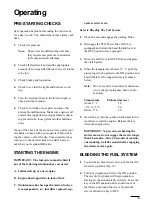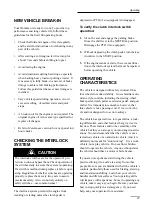
of wheels.
Hydraulic Lift (Fig. 9)—Raises and lowers bed.
Move rearward to raise, forward to lower.
Figure 9
1. Gear shift lever
2. Differential lock
3. Parking brake
4. High-low range shifter
5. Hydraulic lift
6. Hydraulic lift lock
7. Passenger hand hold
8. PTO lever (optional)
IMPORTANT: When lowering the bed, hold the
lever in forward position for 1 or 2 seconds after
the bed contacts the frame to secure it in the low-
ered position.
IMPORTANT: Do not hold the hydraulic lift in
either the raise or lower position for more than 5
seconds after the cylinders have reached the end
of their travel. The hydraulic pump may over-
heat, resulting in pump damage.
Hydraulic Lift Lock (Fig. 9)—Locks the lift lever
so the hydraulic cylinders do not operate when vehi-
cle is not equipped with a bed.
Passenger Hand Hold (Fig. 9)—On the left side of
the passenger seat.
High-Low Range Shifter (Fig. 9)—Adds three
additional speeds for precise speed control.
A.
The vehicle must be completely stopped before
shifting between High and Low range.
B.
Shift only on level ground.
C.
Depress the clutch pedal fully.
D.
Move the lever fully forward for High and fully
rearward for Low.
HIGH is for higher speed driving on level, dry sur-
faces with light loads. LOW is for low-speed dri-
ving. Use this range when greater than normal
power or control is required. For example, steep
grades, difficult terrain, heavy loads, slow speed but
high engine speed (spraying).
NOTE: There is a location between HIGH and LOW
in which the transaxle is in neither range. This
should not be used as a neutral position because the
vehicle could move unexpectedly if the HIGH-LOW
shifter is bumped and the gear shift lever is in gear.
Tilt Steering Lever (Fig. 10)—Lever on right side
of the console lets you adjust the steering wheel for
your comfort.
Horn Button (Fig. 10)—Pressing this button acti-
vates the horn.
Coolant Temperature Gauge (Fig. 10)—Registers
coolant temperature in the engine. Operates only
when the ignition switch is in the On position.
Engine Low Oil Pressure Light (Fig. 10)—This
light glows if engine oil pressure drops below a safe
level while the engine is running. If the light flickers
or remains ON, stop the vehicle, turn off the engine
and check the oil level. If the oil level was low, but
adding oil does not cause light to go out when the
engine is restarted, turn the engine off immediately
and contact your local TORO distributor for assis-
tance.
Controls
16
1
6
5
3
8
7
2
4
When raising or lowering a bed or implement,
hydraulic oil will bypass over a relief valve, stop-
ping power assist to the steering, which increases
steering effort. Release the lift levers to NEU-
TRAL immediately after the bed or implement is
raised or lowered to regain assist to the power
steering.
CAUTION
















































